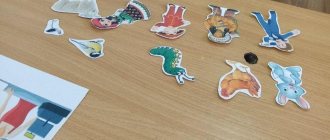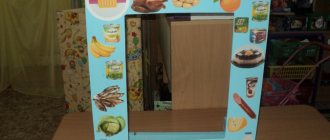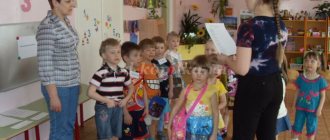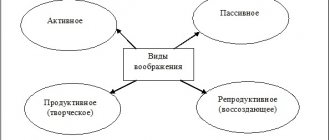Role-playing game: principles of organization and tasks
Elvira Grezeva
Role-playing game: principles of organization and tasks
Introduction
Role-playing game is the main type of play for a preschool child. Playful activities make a huge contribution to the development of a preschooler’s personality. It is in play that the social life of children is most fully activated, that is, the formation of a children's society occurs. In play, as the leading activity of preschool children, mental processes are actively formed or restructured.
Play is social by origin and nature. Its occurrence is not associated with the action of some internal, innate, instinctive forces, but with the very specific conditions of a child’s life in society. The time when a child cannot yet be taught to master the tools of labor and at the same time he already consciously lives within society and is organically connected with it , has become the period of play. Indicative in this context is the fact that during the game the child not only calls himself by the name of the corresponding adult (“I am an astronaut”, “I am a mother”, “I am a doctor”, but, most importantly, acts like an adult , whose role he has taken upon himself, and identifies himself with him. Through the fulfillment of a play role, the child’s connection with the world of adults is realized.
Role-playing game is an activity in which children take on the labor and social functions of adults and, in play conditions specially created by the children themselves, reproduce the activities of adults and the relationships between them.
Story-based play influences the all-round development of a child. Through play, the child enters the world of adults, masters moral values, learns what is good and what is bad, and acquires social experience. In the game, his basic needs for independence, in communication with peers are satisfied, the child’s mental development occurs, all mental processes develop, especially imagination and imaginative thinking; moral development occurs in the game: the child learns to yield, empathize, sympathize, a responsible attitude towards the work performed is formed, volitional behavior develops, the ability to subordinate one’s behavior to the rules of the game, and one’s emotional sphere develops.
Stages of formation of a plot-role-playing game
Organizing a role-playing game for the comprehensive development of a child requires systematic, skillful influence on it, therefore it is very important for the teacher to organize without disturbing children's creativity.
When leading role-playing games, educators are faced with the following tasks :
• development of the game as an activity;
• expanding the topics of children's games, deepening their content;
• acquiring positive social experience;
• using the game to educate children's groups and individual children;
•development of all aspects of the personality: movements, all mental processes (thinking, imagination, memory, speech, personality traits and character traits, strengthening and further development of the child’s emotional and volitional manifestations;
• preparing a preschooler for life in society, socializing his personality.
Management of the game is aimed at its gradual formation, taking into account those factors that ensure the timely development of gaming activity at all age levels of preschool childhood:
— at the first stage (1.5-3 years)
The main content of the game is actions with objects.
They are carried out in a certain sequence, although this sequence is often disrupted. The chain of actions is plot-based . The main subjects are everyday ones . The actions are monotonous and often repeated. Roles are not designated. In form it is game or a single-player game . Children willingly play with adults . Independent play is short-lived .
As a rule, the stimulus for the emergence of a game is a toy or a substitute object previously used in the game. - at the second stage (3 years - 4 years, as at the first level, the main content of the game is actions with an object. These actions unfold more fully and consistently in accordance with the role, which is already indicated by the word. The sequence of actions becomes the rule. The first interaction occurs between participants based on the use of a common toy (or direction of action)
.
Associations are short-lived. The main subjects are everyday ones . The same game is repeated many times.
Toys are not selected in advance, but children often use the same ones - their favorite ones. The game involves 2-3 people. -at the third stage (5-6 years)
The main content of the game is still actions with objects.
However, they are complemented by actions aimed at establishing various contacts with playing partners. Roles are clearly defined and assigned before the game begins. Toys and objects are selected (most often during the game)
in accordance with the role.
The logic, the nature of actions and their direction are determined by the role. This becomes the basic rule. The game often proceeds as a joint game, although interaction is interspersed with parallel actions of partners who are not related to each other and are not correlated with the role. The duration of the game increases. The plots become more diverse: children reflect everyday life, the work of adults, and vibrant social phenomena.
At the fourth stage (6-7 years)
The main content of the game is a reflection of the relationships and interactions of adults with each other.
The themes of the games are varied; it is determined not only by the direct, but also by the indirect experience of children. Games are joint and collective in nature. Associations are stable. They are based either on children’s interest in the same games , or on the basis of personal sympathies and affections. Games of the same content are not only repeated for a long time, but also develop, become enriched, and exist for a long time. The game clearly has a preparatory stage: distribution of roles, selection of game material, and sometimes its production (homemade toys)
. The requirement to comply with the logic of life applies not only to actions, but also to all actions and role behavior of the participants. The number of children involved in the game increases to 5-6.
The role of the teacher in guiding the role-playing games of preschool children depends on the age of the children, and each stage of the development of the game has its own tasks :
Principles of organizing a story game:
1. The teacher should play with the children , taking the position of a “ playing partner who knows how to play .”
2. The teacher should play with children throughout preschool childhood, but at each stage the game should be developed in such a way that the children immediately “discover”
and learned a new, more complex way of building it.
3. when developing gaming skills, simultaneously orient the child both to the implementation of the gaming action and to explaining its meaning to partners - an adult or a peer.
4. at each age stage, the pedagogical process of organizing play should include moments of developing gaming skills in joint play between the teacher and children and creating conditions for independent play of the preschooler.
Techniques for directing role-playing games for preschoolers are traditionally divided into direct and indirect.
Indirect guidance of the game is carried out by enriching children's knowledge about the surrounding life, updating game materials, etc., i.e., without direct intervention in the game. This preserves children's independence during play.
Knowledge about the structure of a specific work activity: its goals, means, sequence of actions, result; Children receive knowledge about the interaction and relationships between people in the labor process and the distribution of responsibilities between them:
• during classes, during observations on walks,
• in conversations with children,
• when reading books,
• through conversations and viewing paintings, illustrations,
• in free time from classes, etc.
The process of getting to know the environment should embrace children’s feelings and arouse in them a deep interest in events and phenomena.
The next technique of indirect guidance is introducing toys and creating a play environment before the start of the game, in order to arouse interest (both playful and educational)
to a new topic or to enrich the content of an existing one.
Toys must be freely used by children. The environment in the play corner should change from time to time, but with caution so as not to force play against your will.
Direct leadership techniques:
• role-playing participation in the game,
• participation in the conspiracy of children,
• clarification, help, advice during the game,
• proposal of a new game theme, etc.
These techniques purposefully influence the content of the game, the relationships between children in the game, and the behavior of the players . The main condition for their use is to preserve and develop children’s independence in play.
The integrated method of guidance is a system of pedagogical influences that promote the development of children’s independent story-based play , based on its age characteristics and the potential development of the child’s intelligence.
In the course of complex management of a plot -role-playing game, 4 groups of tasks (“Methodology for the integrated management of a plot-role-playing game ” by E. V. Zvorygina and N. F. Komarov).
1 - tasks aimed at developing the plot of the game .
2 - tasks aimed at developing the game as an activity (goal, motive, means, methods, result)
.
3 - tasks of forming relationships.
4 - tasks of developing independence and creativity.
These tasks are solved by 4 components of comprehensive management:
Component 1 - Familiarization with the environment (planned, pedagogically active enrichment of children’s life experience)
Component 2 - Enrichment of gaming experience (joint (educational)
games between a teacher and children aimed at conveying to them the gaming experience of traditional gaming culture)
Component 3 - Enrichment of the subject-game environment (timely change of the subject-game environment, taking into account the enriching life and gaming experience)
Component 4 - Activating communication between an adult and children (activating communication between an adult and children, aimed at encouraging them to independently use new ways of solving game problems and new knowledge about the world in the game).
Objectives and methods of directing role-playing games in different age groups
Early age.
Methods of direct guidance - emotional communication between an adult and a child in joint play
- demonstration of methods of action with objects, accompanied by the speech of an adult
- joint play activities with the teacher
- inclusion of the teacher in the child’s play (to solve certain game problems )
- demonstration, training in the use of substitute objects, drawn markers of the playing space, imaginary objects in the game
- use of activating dialogue between the teacher and the child
- prompt questions
Techniques of indirect leadership.
- selection of toys with certain properties
- examination of household items and objects in the immediate environment, conversation about their purpose
- observation of the actions of adults using household items and objects of the immediate environment
— various small errands for the child ( bring a chair , hang a towel on a hook)
- involving the child in all possible participation in labor activities (cleaning toys, things)
- examination of subject pictures, small stories and illustrations
- creating a ready-made play environment (suggesting a situation - a doll and a cup are placed next to each other)
- changing a familiar game situation (replacing toys, adding new ones)
- the teacher poses a problem situation
Conclusion: In everyday life, a child gains practical experience in operating objects and transfers this experience into independent play. Play at an early age is of an introductory nature and represents an object-based play activity. By the end of early childhood, the game acquires the status of a display game, in which operations with objects become actions aimed at achieving a certain effect with the help of a given object.
Junior preschool age.
Direct leadership techniques.
Second junior group
Teaching ways to reflect reality in games:
- inclusion of the teacher in the game (in order to convey gaming experience)
- teaching game actions and role-playing dialogue by example
Activating communication between the teacher and children during the game:
- questions (Who are you? Or are you a driver? I’m late for work, please give me a lift)
- encouragement
-encourages statements (Ask your daughter, she’s not hungry)
- teacher’s help to unite in the game (You’re probably bored alone, invite Olya, she’s also walking with her daughter)
Middle group
- inclusion of the teacher in the game, taking on the main or secondary roles (not often)
— the teacher’s entry into a role-playing conversation (in order to activate the role-playing dialogue)
Techniques of indirect leadership.
Enriching the real experience of children in active activities:
- introducing vivid images and impressions into classes to familiarize yourself with the environment
- excursions, observations, meetings with people of certain professions, accompanied by conversations with children
- creating situations that encourage the child to enter into relationships with others (assignments)
- reading works of fiction, dramatizing fairy tales
- watching other children play
-reminders about interesting facts from life.
Organization of the subject-game environment
- a combination of toys, substitute items, role attributes, imaginary toys
- introducing a new toy into the environment
- children making attributes for the game
Enriching children's social experience in everyday life:
- getting to know the environment through active activities (observations, excursions, conversations, using TSO, reading literature, looking at illustrations and paintings)
- creation by the teacher of special situations in order to establish contacts between the child and others.
Organization of educational games by the teacher:
- theatrical games
- games like “Guess who came?”
"Guess who I'm impersonating?"
— didactic games “Who needs what for work”
…
Creating a gaming problem situation: - using gaming equipment (attributes, decorations, clothing items, toys)
- through activating communication between the teacher and children.
- encouragement
- attracting inactive children to the game.
Conclusion: Based on in-depth knowledge about the world around them, children creatively implement interesting ideas in play. The game is undergoing changes from a figurative role-playing game to a plot-role-playing game . By the age of 5, children have mastered well the methods of object-based play actions, play freely with toys , with substitute objects, with imaginary objects, easily give verbal designations, and are able to convey the characteristic features of a role using means of expressiveness. Children are able to engage in role-playing interactions for a longer period of time.
Senior preschool age.
Direct leadership techniques.
— Inclusion of the teacher in the game, taking on a role (main or secondary)
– not often, as necessary (showing a speech sample, collective discussion of the role behavior
of the players after the game ).
Techniques of indirect leadership.
– enriching children’s social experience through all types of activities (observations, excursions, reading fiction, watching children’s TV shows, conversations)
— involving children in the production of attributes and design of playing fields.
Creating conditions for the development of creative role-playing games :
- creation of a subject-based play environment (thematic play corners typical for younger and middle ages - “Hospital”
,
“Barbershop”
, where play equipment and toys are located in a characteristic way, are not typical for older people)
- arrangement of various gaming materials in butts (boxes, containers, drawers with conventional and realistic toys and attributes,
- inclusion of “semi-finished toys”
for making homemade products,
— replenishment and enrichment of the gaming environment in accordance with the knowledge acquired in the classroom.
Adult help:
- remember events that are more suitable for the game, establish their sequence
- plan the course of the game, sequence of actions
- distribute roles, agree on plans,
- assistance in solving game problems , maintaining cognitive interest in the game,
- watching children play,
- direction of children’s plans and actions (advice, hint, question, changing the play environment)
- creation of problematic situations (flexible influence on the game concept, plot , complication of ways of displaying reality,
- create a game situation,
- individual work (the child does not know how to play, you can use the experience of children who play .
Conclusion: by the age of five, children are able to independently organize a role-playing game - choose a topic , create conditions, perform appropriate game actions and rules of behavior. The teacher uses mainly indirect methods of guiding the game.
Senior preschool age.
Direct leadership techniques:
- inclusion of the teacher in the game, taking on the role - not often, as necessary (showing a speech sample, collective discussion of the role behavior of the players after the game ).
Indirect leadership techniques:
1.Enriching the real experience of children in active activities:
– enriching children’s social experience through all types of activities (observations, excursions, reading fiction, conversations)
;
— involving children in the production of attributes and design of playing fields.
2. Creating conditions for the development of creative role-playing games :
— creation of an object-based play environment (thematic play corners)
;
- arrangement of various gaming materials in boxes, containers, boxes with conventional and realistic toys and attributes;
— inclusion of “semi-finished toys”
for making homemade products;
— replenishment and enrichment of the gaming environment in accordance with the knowledge acquired in the classroom.
3.Adult help:
- when planning the course of the game, the sequence of actions;
- when distributing roles, coordinating plans;
- when solving game problems , maintaining cognitive interest in the game;
- watching children play;
- direction of children’s plans and actions (advice, hint, question, changing the play environment)
.
— creation of problematic situations (flexible influence on the concept of the game, plot , complication of ways of displaying reality);
- when creating a game situation.
4. Individual work (the child does not know how to play; you can use the experience of children who play ).
• working with six-year-olds - indirect influences are especially effective, primarily through games, fairy tales, songs, and music.
CONCLUSION
Play is the main activity of a child up to primary school age. The game is constantly attractive to the child and allows him to fulfill his aspirations. Often, in play, a child discovers qualities in himself that were not previously noticeable either to him or to those around him, and discovers new possibilities in himself. The game is the best way to train certain skills.
There are no positive qualities that cannot be developed in a child during play. Play is the main way to develop these qualities, since it is more attractive for children and children engage in it with more pleasure than, for example, just studying at school. Through play, you can develop a child’s cognitive characteristics, prepare him for life in modern society, and make him believe in his strengths and capabilities.
The game , then, after the child graduates from school, realizes itself in his adult life as business and “adults”
role-playing games.
It is quite difficult for a modern person to realize himself in society without playing. So, play , being the most important factor in a child’s development, is not only the implementation of this development, but also contributes to the improvement of the skills of an adult.
Types and examples of children's entertainment
Role-playing games are one of the important components of children's development. Activities like these help stimulate better imagination. Pretense or artistic play becomes a significant component of children's development.
“Mothers and daughters” and other emotionally charged activities
With the help of such entertainment, a child can form a clear social model of behavior in a team. For example, instill in girls the maternal instinct and mechanisms for handling the future newborn. In addition, the event helps to develop communication experience to the fullest.
In the same category are emotional games that evoke experiences that are not yet available: raising children, adult family relationships. It is worth showing the kids your own example: pick up a doll, kiss it, then lull it to sleep. My daughter will quickly learn to repeat such actions. It is useful for the smallest babies to demonstrate body parts on the baby doll.
“School”, “hospital”, “shop”, other situational actions
These activities are often accompanied by the use of special props: toy cash registers, money, doctor’s kits. In addition to modeling behavior and forming reactions to different formats of situations, an understanding of the functionality of additional props is developing. While playing with your baby, adults need to be shown how to count money correctly. For example, teach how much is fifty and ten, what “money” the buyer needs to return as change.
"Behavior Rehearsal"
This event is a simulation of an incident or an imaginary situation, the repeated experience of which will help to gain some experience in the game. “Rehearse” your child’s upcoming birthday, remembering the mistakes of the past holiday. You can imagine a “mock zoo” after returning from a real event. Such pastime allows you to get rid of psychological stress, it is often used to cause “re-experiencing” both positive and negative emotions. After this, it is easier to analyze the events and help the baby overcome stress (during the course of this game, it is advisable to ask the baby leading questions).
When a child is scared by an animal at the zoo, then re-experiencing a similar situation with a rubber animal will help get rid of the fear. For small children, repeating certain activities is suitable: rocking the child, turning the steering wheel. Help your baby and set an example by doing it several times to reinforce it.
Theater and masquerade
One of the most favorite games for children is stage dressing. This is explained not only by the inclusion of adults in the entertainment, but also by the approach of a favorite holiday (birthday, New Year, May Day). A costume performance will help you fully “fit into” the role, as well as gain admiration from your surroundings, as well as a feeling of “anonymity.” This will rid the baby of phobias and complexes, he will be more relaxed, since he is wearing a mask and no one will be able to recognize him.
Role-playing games are important in the development of children - they form a significant part of training and upbringing. Such events help to better strengthen the imagination and practice various skills. Children enjoy learning about the world through fun because communication allows them to exchange ideas. Through such games, the baby imagines himself in the future.





